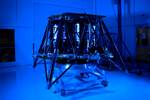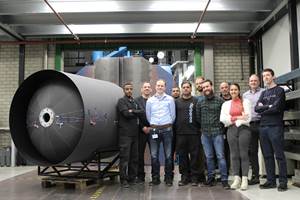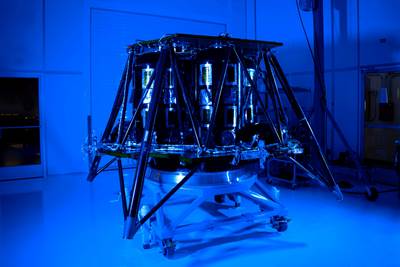Firefly Aerospace’s Blue Ghost Mission 1 successfully launches, begins 45-day transit to the moon
Following launch vehicle separation, Firefly’s composites-intensive Blue Ghost lunar lander acquired signal and completed on-orbit commissioning.
On Jan. 15, Firefly Aerospace’s (Cedar Park, Texas, U.S.) Blue Ghost lunar lander, launched on a SpaceX Falcon 9 rocket, successfully acquired signal and completed on-orbit commissioning. With a target moon landing date of March 2, 2025, Firefly’s 60-day mission is now underway, including approximately 45 days on-orbit and 14 days of lunar surface operations with 10 instruments as part of NASA’s Commercial Lunar Payload Services (CLPS) initiative (read “Firefly awarded $179 million NASA contract for moon delivery”).
Blue Ghost Mission 1, named Ghost Riders in the Sky, launched from Launch Complex 39A at NASA’s Kennedy Space Center in Florida, at 1:11 a.m. EST. Blue Ghost separated from the Falcon 9 rocket in a highly elliptical Earth orbit at 2:17 a.m. EST and established communications with Firefly’s Mission Operations Center in Cedar Park, Texas, at 2:26 a.m. EST. On-orbit spacecraft commissioning was then completed by 5:30 a.m. EST, which included verifying attitude determination and control capabilities, increasing the data transfer rate, establishing a power-positive attitude and completing initial lander health checks.
“On behalf of Firefly, we want to thank SpaceX for a spot-on deployment in our target orbit,” says Jason Kim, CEO of Firefly Aerospace. “The mission is now in the hands of the Firefly team. After all the testing conducted and mission simulations completed, we’re now fully focused on execution as we look to complete our on-orbit operations, softly touch down on the lunar surface and pave the way for humanity’s return to the moon.”
Firefly’s Blue Ghost will spend approximately 25 days in Earth orbit, four days in lunar transit and 16 days in lunar orbit, enabling the team to conduct robust health checks on each subsystem, calibrate the propulsion system in preparation for critical maneuvers and begin payload science operations. The NASA payloads operating during the Earth-to-moon transit include LuGRE, which will monitor GPS signals to help extend Global Navigation Satellite System capabilities to the lunar surface, and RadPC, which will begin demonstrating the computer’s ability to withstand space radiation while on-orbit.
BLUE GHOST
Upon landing in Mare Crisium, Blue Ghost will operate 10 NASA payloads for a complete lunar day (about 14 Earth days) and support several science and technology demonstrations, including lunar subsurface drilling, sample collection, X-ray imaging and dust mitigation. Just before lunar night, Blue Ghost will also capture high-definition imagery of a total eclipse from the moon where the Earth blocks the sun. Blue Ghost will then capture the lunar sunset, providing data on how lunar regolith reacts to solar influences during lunar dusk conditions, before operating several hours into the lunar night.
“Toward the end of Blue Ghost Mission 1, we expect to capture a phenomenon documented by Eugene Cernan on Apollo 17 where he observed a horizon glow as the lunar dust levitated on the surface,” says Kim. “As a tribute to the last Apollo astronaut to walk on the moon, we’re honored to have the opportunity to watch this incredible sight in high definition.”
The Ghost Riders in the Sky mission is one of four task orders Firefly has been awarded by NASA CLPS as part of NASA’s Artemis campaign that is working to establish a long-term presence on the moon and prepare for Mars exploration. Firefly will provide regular mission updates on X and on the Blue Ghost Mission 1 web page.
Related Content
A new era for ceramic matrix composites
CMC is expanding, with new fiber production in Europe, faster processes and higher temperature materials enabling applications for industry, hypersonics and New Space.
Read MoreAirborne delivers composite upper stage tank for EU ENVOL project
Nine-member consortium targets development of low-cost, green vertical orbital launcher with manufacture of an ultra-lightweight composite tank design in an automated manufacturing environment.
Read MoreNew GTL breakthrough in composite tubing for liquid hydrogen in aircraft and space vehicles
Tests versus stainless steel tubing show 10 times faster chill down, fuel flow in 2 seconds and less boil-off for significantly faster fueling and refueling of LH2-powered space vehicles, aircraft and trucks.
Read MoreComposite molding compound replaces Invar for lightweight small satellite structures
Patz Materials and Technologies and Lawrence Livermore National Laboratory developed a new monolithic optics housing with 80% less weight, near-zero CTE and the high-volume manufacturing required for commercial space.
Read MoreRead Next
Firefly Aerospace completes composite Blue Ghost lunar lander
First of two lunar missions under NASA’s CLPS initiative will launch in 2024 and conduct diverse technology demonstrations and scientific investigations on the moon’s surface.
Read MoreFirefly Aerospace closes oversubscribed $175 million Series D raise
The end-to-end space transportation company looks to its future launch, lunar and on-orbit services and capabilities.
Read MoreIntuitive Machines debuts moon buggy for Artemis program
IM’s Moon RACER is one of three lunar terrain vehicle (LTV) designs being considered by NASA for future operations on the lunar surface.
Read More






























